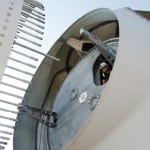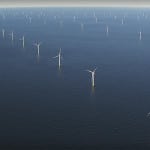Siemens Energy in June announced it had produced the first batch of its new B75 Quantum wind turbine rotor blades, fiberglass components 75 meters (m) in length that were cast in one piece (Figure 3). The blades were manufactured to be installed this fall on Siemens’ second prototype of the German firm’s SWT-6.0 6-MW offshore wind turbine at Denmark’s Østerild Test Station. The wind turbine’s rotor diameter of 154 m will sweep an area of 18,600 square meters—equal to the area of about two and a half soccer fields.
 |
| 3. Cutting-edge blade. Siemens Energy in June produced the first new B75 Quantum wind turbine rotor blades, fiberglass components that are 75 meters in length and cast in one piece. Courtesy: Siemens |
The 75-m-long blade marks the tremendous progression of wind turbine technology. According to a recent report in the journal Environmental Science & Technology, the size of wind turbines has increased 10-fold over the past 30 years: The first commercial wind turbine had a capacity of just 30 kW and had 5-m-long rotor blades and a 10-m rotor diameter. On the horizon are super-giant wind turbines approaching 304.8 meters in diameter, the authors of that study claim. “Thus, the energy capture area and the turbine capacity have grown by a factor of 200 in the last 30 years,” Siemens said in a press release in June.
The process to manufacture the first B75 blade posed several challenges for the project team, requiring a mold of two parts so it could be transported without hitches over a distance of 575 kilometers. Siemens also had to build the piece without glue joints so it would withstand the tremendous force of winds, and it did so using its patented IntegralBlade process. The firm says that when operating at a wind speed of 10 m/second, a 154-m rotor extracts energy from 200 tons of air per second. The aerodynamic and structural design of the blade for the massive rotor also incorporates unique airfoil profiles and redesigned tip and root sections, using Siemens’ “flatback” profiles to minimize root leakage and provide higher lift.
In March, LM Wind Power’s 73.5-m blades became the first 70-plus-meter blades to be installed when Alstom inaugurated its 6-MW Haliade 150 direct-drive offshore turbine at Carnet in the Loire-Atlantique region of France (Figure 4). Before development of that turbine, LM Wind Power’s 61.5-m blade, the LM 61.5P, was among the world’s longest series-manufactured rotor blades.
 |
| 4. Heightened wind. Alstom erected its 6-MW Haliade 150 direct-drive offshore turbine at Carnet in the Loire-Atlantique region of France in March. The turbine features LM Wind Power’s wind turbine blades, which are 73.5 meters long. Courtesy: Alstom |
According to LM Wind Power, the composite structure developed specifically for the Haliade wind turbine in close collaboration with Alstom was designed for high energy capture while keeping loads down. Materials technology was a decisive parameter in the design of the fiberglass blade, and the two companies were able to retain a 3.2-m root diameter, similar to the LM 61.5P, while limiting blade mass to just 26 metric tons, LM Wind Power said.
The nacelle of Alstom’s 6-MW Haliade 150 wind turbine soars 100 m above the ground; the wind turbine and its support structure have a total combined weight of 1,500 metric tons. The first Haliade 150 will now undergo a series of year-long tests on land at the Carnet site before a second turbine is placed in the sea off the Belgian coast this fall. Pre-series production is planned for 2013 with production in series scheduled to start in 2014.
—Sonal Patel is POWER’s senior writer.










